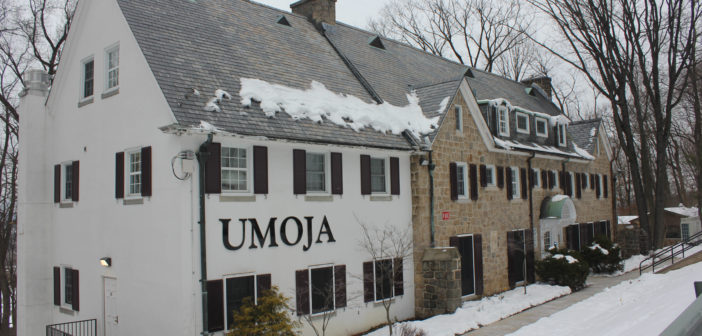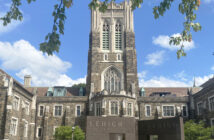Above Lehigh’s Asa Packer campus sits the Hill, an on-campus housing locale largely made up of sorority and fraternity chapter houses. Among them is the Umoja House, a multicultural community open to students of all academic years and demographics.
The Umoja House was established in 1989 as a safe space for students of color and other underrepresented students, Dr. Henry Odi, deputy vice president for equity and community, said. While principled on unity — the meaning of the Swahili word “Umoja” — the house was born from a dark, divided time in Lehigh’s history.
Odi said Lehigh’s campus became a hostile place for students of color in the late 1980s. Following the 1986 murder of Jeanne Clery, a white student who was murdered in her dorm room by a Black student, other students of color became suspects, he said.
“Our students of color had a decision to make,” Odi said. “All of them (could) leave Lehigh, which some of them did … or stay and figure out what they can do to help the university create a welcoming and supportive institution.”
Dr. Leon Caldwell, a sophomore at the time, chose not to walk away, Odi said.
Caldwell said on the overwhelmingly white and wealthy campus, students of color faced academic, social and emotional challenges. While they had relationships and connections with one another, they were missing a place of their own.
“The model for the Umoja House came from the DuBois Scholar House at the University of Penn,” Caldwell said. “I thought it was a vibrant enclave on that campus where there were predominantly Black and brown students who lived in a community.”
He described the DuBois house as an intellectual and social hub, and a thriving and safe place for students of color. He said he was inspired by this and thought a similar space could be created at Lehigh. Thus, the idea for the Umoja House was born.
However, when Caldwell approached then-Lehigh President Dr. Peter Likins with his proposal for the house, Caldwell said he was met with some resistance. He said Likins was concerned that the house would mean minority students were segregating themselves.
“Nobody ever asked the question of ‘aren’t the white students segregating themselves?’” Caldwell said. “The segregation was built into the system, and very few people understood that. Matter of fact, we’re asking you to be a part of the campus.”
Inequity was in the structure of the university at the time, specifically in the housing system, Odi said. The housing selection process functioned as a lottery at the time and was not favorable to students of color.
The Umoja house would function as a solution to the housing issue.
However, Caldwell said beyond being a housing solution, the house was about retention, and would serve as a place to escape hostility and hold conversations.
“We didn’t want to recreate the Hill,” Caldwell said. “We just wanted a place where our music wasn’t looked down on, our foods, the way we styled our hair, or whatever it was, wasn’t seen as deviant because it was different.”
Odi worked as the assistant provost at Lehigh at the time, in the same suite as Likins, which included him in the conversation between Likins and Caldwell.
Odi said due to Caldwell’s persistence and the university’s commitment to students of color being both taken care of and welcome, the proposal was approved after a few days of discussion.
The Umoja house is still a safe space where students from all different backgrounds can share and celebrate their culture 33 years later.
The current Gryphon in the Umoja house, Noor Musharraf, ‘23, said the house now has about 20 residents from all different demographics.
“I think that a space is what you make of it,” Musharraf said. “It was created as a safe space and many years later, it’s holding up to that.”
Juan Rosas, ‘25, has been living in the house since his first year at Lehigh. He said he knew he wanted to live in the Umoja House before coming to Lehigh, as he comes from a community of Black and Latinx people and knew the house would be a place where he feels included.
“We’ve definitely built a strong community,” Rosas said. “I feel like we’re all able to express ourselves and our different backgrounds and appreciate one another’s cultures.”
Rosas said the house has several communal spaces, including a classroom, a kitchen and a dance studio. However, he said he would like to see them being utilized more by other organizations and groups on campus.
Musharraf said she hopes the house can be a bustling space for all campus clubs to use in the future.
“There are so many different spaces that I would love to see other campus partners use,” she said. “I always want it to be full.”
Musharraf said the Office of Residence Life is trying to get the house back up and running at full steam after COVID-19.
Odi said he feels the community needs to do a better job of keeping the history of the house alive. He said the strongest effort in recent years was the 30th anniversary celebration of Umoja in 2019.
“Any student that came after that would be clueless about the history of the house,” he said. “I think one way of (creating) a relationship is events being hosted … that bring back the alums who lived in the house to engage with the current residents.”
Caldwell said he feels after his class graduated from Lehigh, there was no real follow-up or acknowledgment for Umoja.
“The reason why you don’t hear much about the history is because the university had not really documented it until the 30th anniversary,” Caldwell said. “What the 30th did was give us a space to tell the story.”
Odi said in order for the community to raise awareness about Umoja and its history, events should be hosted at least once every semester and should include students from outside the house, as well as past and present members.
While he believes the house still holds the potential of being a safe place for both students of color and their allies, Caldwell said he would like to see alumni being invited back in structured ways to connect with students.
“I think looking forward … the whole notion of Umoja doesn’t have to stop,” Caldwell said. “It’s been a life principle of mine that doesn’t stop once you leave campus.”






Comment policy
Comments posted to The Brown and White website are reviewed by a moderator before being approved. Incendiary speech or harassing language, including comments targeted at individuals, may be deemed unacceptable and not published. Spam and other soliciting will also be declined.
The Brown and White also reserves the right to not publish entirely anonymous comments.
2 Comments
I hope no one gets a negative view of Dr. Likins from this.
Dr Likens was right to be concerned about the double standard of attempting to integrate at the same time they were specifically establishing a segregated living situation.
They took away a fraternity residence that was protected by right of association laws & replaced it with a group of people that were also protected by right of association laws.
Blacks wanted to hang out with blacks if given preference just as whites wanted to hang out with other whites. You saw it in the dining halls and off campus at restaurants. It was the way of the world at that time & perhaps continues today on campus in many cases.
Likens was trying to integrate & neither blacks nor whites necessarily wanted that & Umojo House fostered segregation against Likens instincts.